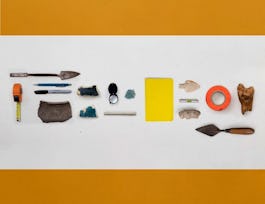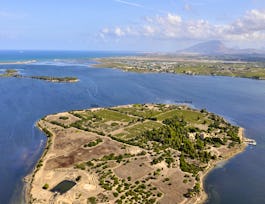The objective of this course is to provide an overview of the culture of ancient Rome beginning about 1000 BCE and ending with the so-called "Fall of Rome". We will look at some of the key people who played a role in Rome, from the time of the kings through the Roman Republic and the Roman Empire. We will also focus on the city of Rome itself, as well as Rome's expansion through Italy, the Mediterranean, and beyond.


Roman Art and Archaeology
Taught in English
Some content may not be translated
50,768 already enrolled
(628 reviews)
Details to know

Add to your LinkedIn profile
13 quizzes
See how employees at top companies are mastering in-demand skills


Earn a career certificate
Add this credential to your LinkedIn profile, resume, or CV
Share it on social media and in your performance review

There are 6 modules in this course
Here you can find all of the introductory information, course syllabus, and helpful resources.
What's included
2 videos7 readings
In the Early Iron Age (ca. 1000 BCE), civilization in Italy was rather simple. The most sophisticated cultures in the peninsula were not the Romans at all, but rather groups to the north of Rome who have come to be called The Villanovans, who exploited the metal resources of northern Italy even before the officially noted founding of Rome. Later the Etruscans would appear (ca. 800 BCE), Rome's first great rivals. The Etruscans were a loose confederation of city-states north of Rome who even expanded into Rome and further south, as far as Pompeii. The Etruscans are particularly noted for their magnificent art, in particular the glorious painted tombs of Tarquinia.
What's included
29 videos3 quizzes1 peer review
Having thrown off the Etruscans in 509 BCE., Rome emerged as independent Latin community that quickly became known for its disciplined army and militaristic intentions. As the Romans expanded throughout the Mediterranean, it came into contact with various cultures, all who had an influence on the young power, especially Greek culture, art, and architecture. By the end of this period Rome may have grown to a million people. The first century BCE. was a time of amazing development in many fields of artistic endeavor, but it was also a time of civil unrest as soldiers became more loyal to their commanders than to the state. Leaders such as Sulla, Marius, Julius Caesar, Mark Antony and others took advantage of this turmoil, which culminated with the powerful influence of the decadent Egyptian charmer Cleopatra and the emergence of Octavian.
What's included
23 videos3 quizzes1 peer review
Augustus - formerly known as Octavian - set the tone for the next major phase of Rome: the Roman empire. His family-related successors, the Julio-Claudians, would continue his rule. Yet none of his successors had the charisma or vision of Augustus himself, and some such as Caligula and Nero have become synonymous with profligacy and decadence of an extreme nature. By the year 69 CE. Rome was in chaos. But the emperor Vespasian restored order and dignity - not to mention humility - to the office, and instituted his own dynasty, the Flavians. Unfortunately, Vespasian's second son, Domitian, brought his Flavian dynasty to an end through dreadful administration. Domitian was murdered in 96 CE.
What's included
19 videos2 readings3 quizzes1 peer review
Rome is said to have reached its zenith in security and expansion during the period of the "Five Good Emperors" (96 to 180 CE.). The time of Trajan (98 to 117 CE.) was a particular epoch of conquest and building, highlighted by the construction of Trajan's Markets and enormous Forum, the ruins of which still dominate the center of Rome. Trajan's successor, Hadrian, was a horse of a different color. He was himself an architect obsessed with circles, squares, spheres, and cubes. And his fondness for Greek art bordered on manic.
What's included
12 videos2 readings2 quizzes1 peer review
What does it mean to talk about the fall of Rome? The far-flung empire collapsed in varying degrees in different places at different times. In the fourth century enormous earthquakes caused such devastation that in the Roman east the whole fabric of ancient religious belief was called into question. In central Italy along the Tiber River an epidemic of malaria, a virulent new-mutated strain from North Africa, left many dead. The legacy of Rome, however, continued into the Carolingian and Byzantine empires. And yet the city of Rome underwent a major revival in the later Middle Ages, continuing through the Renaissance, Baroque, Rococo and Romantic Periods, playing a major role in the foundation of our own country.
What's included
23 videos2 quizzes1 peer review
Instructor

Offered by
Recommended if you're interested in History

Rice University

Coursera Project Network

Yale University
Why people choose Coursera for their career




Learner reviews
Showing 3 of 628
628 reviews
- 5 stars
80.28%
- 4 stars
15.89%
- 3 stars
2.38%
- 2 stars
0.63%
- 1 star
0.79%

Open new doors with Coursera Plus
Unlimited access to 7,000+ world-class courses, hands-on projects, and job-ready certificate programs - all included in your subscription
Advance your career with an online degree
Earn a degree from world-class universities - 100% online
Join over 3,400 global companies that choose Coursera for Business
Upskill your employees to excel in the digital economy
Frequently asked questions
Access to lectures and assignments depends on your type of enrollment. If you take a course in audit mode, you will be able to see most course materials for free. To access graded assignments and to earn a Certificate, you will need to purchase the Certificate experience, during or after your audit. If you don't see the audit option:
The course may not offer an audit option. You can try a Free Trial instead, or apply for Financial Aid.
The course may offer 'Full Course, No Certificate' instead. This option lets you see all course materials, submit required assessments, and get a final grade. This also means that you will not be able to purchase a Certificate experience.
When you purchase a Certificate you get access to all course materials, including graded assignments. Upon completing the course, your electronic Certificate will be added to your Accomplishments page - from there, you can print your Certificate or add it to your LinkedIn profile. If you only want to read and view the course content, you can audit the course for free.
You will be eligible for a full refund until two weeks after your payment date, or (for courses that have just launched) until two weeks after the first session of the course begins, whichever is later. You cannot receive a refund once you’ve earned a Course Certificate, even if you complete the course within the two-week refund period. See our full refund policy.



